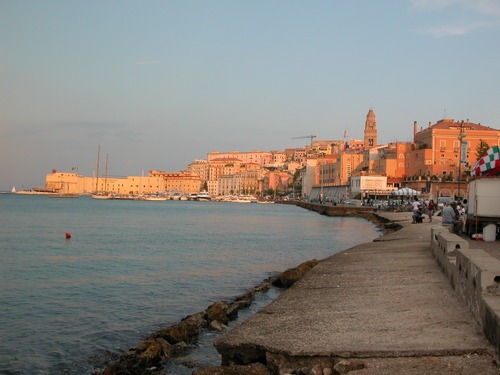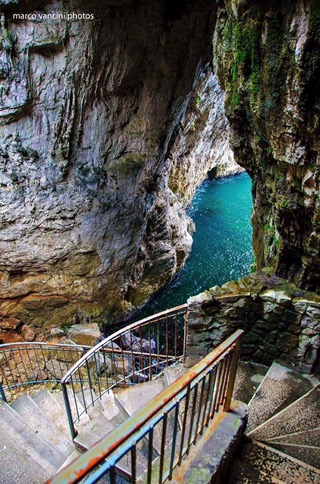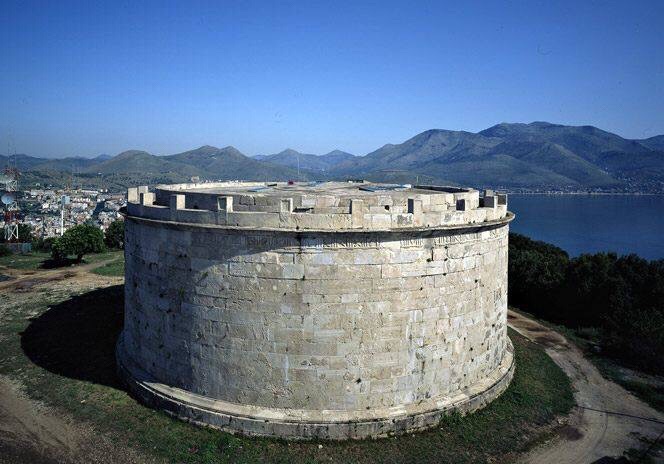

Backgound
The first settlements in the territory of Gaeta date back to the IX-X century BC, but it was not until 345 BC that came under the influence of Rome.
During the Roman period Gaeta became a very popular holiday resort, frequented by emperors, wealthy patricians, consuls and senators famous era. To facilitate their coming was built a new Roman road, the Via Flacca, shorter than Appia. Its territory on the border between Lazio and Campania, was located in preimperiale times within that geographical area called Latium adjectum (Latium Novum). This name was reported to the "added" to the territories Latium vetus (Latium antiquum) following the first conquests of Rome to the south, resulting in the disappearance of other pre-Roman peoples (Volscians, Equi, Ernici and Ausoni). The Roman period are still visible many vestiges, such as the Mausoleum that rises on the top of Monte Orlando Lucio Munazio Plancus, the Roman consul,
The first news of the castle date back to the sixth century in the war against the Goths, in the tenth century it mentions in the papers of Codex diplomaticus Cajetanus, but news of its existence have only in the twelfth century.
Already in the ninth century Gaeta became independent Byzantine imperial authority and in the year 839 the position of Ipato was taken by Constantine I, son of the Count Anatole (founder of the Caetani family) and in fact the first ruler of Gaeta recognized. The Duchy of Gaeta gradually gained its independence and remained alive for more than two centuries, during which Gaeta had its own military strength, political autonomy, judicial autonomy, of their civic legal institutions, its own currency (the "follaro") and considerable economic development through maritime trade.
In the period 1140 dall'839 Gaeta can be fully considered also a Maritime Republic. The gaetani defended their freedom and independence of the Duchy implementing a wise and sometimes unscrupulous political and military action. They resulted in this regard relevant covenants made with the main autonomous states of southern Italy to fight the continuous Saracen raids, but also the agreements signed with the Muslims themselves to defend the duchy against the expansionist ambitions of the papacy.
With the Spanish domination, which began in 1504, the unitary state of South Italy, born in 1140 following the conquests of King Roger II, lost for the first time its independence and became a viceroyalty, nevertheless the role of "fortress" of Gaeta was even more pronounced and the city was equipped on the orders of Charles V of brand new bastion fortifications on the slopes of Monte Orlando, to date against the latest and most powerful firearms.
In 1571 he gathered in the port of Gaeta the papal fleet, under the command of Admiral Marcantonio Colonna, sailed June 24, 1571 to join the rest of the Christian fleet, commanded by Don Juan of Austria, to fight the Saracens. The commander of the papal fleet had received on 20 June 1571 by Pope St. Pius V the Standard of Lepanto, made of silk, which had to be hoisted on the papal flagship.
Admiral Column in Gaeta Cathedral, in front of St. Erasmus, the patron of sailors and revered patron of the city, he vowed that if he won he would give the Standard of Lepanto in the same Cathedral and would put him at the feet of the saint. The battle navaletra the fleet of the "Holy League" and the Ottoman Empire fleet took place October 7, 1571 at Lepanto and was won by Christian forces. On his return to Gaeta Marcantonio Colonna he remained true to the oath and today the banner is exposed in the Diocesan Museum.
In 1734 Gaeta was conquered by Charles III, founder of the Neapolitan branch of the Bourbon dynasty. With Charles the Kingdom of Naples regained its independence after 230 years returning to be the most extensive and important nation-state of the peninsula.
On 25 November 1848, Pope Pius IX took refuge in Gaeta, a guest of King Ferdinand II of Bourbon, following the proclamation of the Roman Republic by Giuseppe Mazzini, and remained there until September 4, 1849, during which Gaeta was the seat institutional and capital "de facto" State of the Church, representing the highest political and religious center of reference for the world of Christianity. It was during this stay that Pope Pius IX, according to tradition enlightened by the Holy Spirit during his prayer at the Chapel of Gold, he decided to write the encyclical Ubi Primum which questioned the Catholic Episcopate on opportunities to proclaim the Dogma Immaculate Conception, which took place on his return to Rome.
On February 13, 1861 Francis II of Bourbon surrendered in Gaeta, the last bastion of his reign, capitulating after 102 days of bombing, the siege of the Savoy troops of General Enrico Cialdini (1860-1861 siege of Gaeta): thus ceased to exist the Kingdom of Two Sicilies.
The Borgo di Gaeta, Gaeta fraction outside the walls, by Royal Decree of 15 March 1897, the town became autonomous under the decisive impetus of its small but influential circle of liberals. He took the name "City of Elena" in honor of the then Princess Elena, the future queen of Italy. Thirty years later, just by Royal Decree of 17 February 1927, the Gaeta municipalities and Elena were again united under the name Gaeta. The Borough identify 'so as neighborhood Porto Salvo, while the part of the walled city as neighborhood Sant'Erasmo.
Also in 1927, precisely on February 6, Gaeta lost the popular ancient fortress qualification to become an important base of the Italian Navy, more particularly it went 'to constitute the main naval base of the Tyrrhenian Sea along the harbor La Spezia.

Gaeta Itinerary
GAETA: ancient city, so much so that, according to legend, its name comes from Enea's nurse. The collective imagination, often, places it in the sea making it an island because of the famous military prison. Gaeta is not an island but a peninsula beautifully situated on the sea.
It
'also a city rich in history: independent duchy and glorious maritime
republic, later incorporated in the Bourbon Kingdom of which will be
the last bastion before the Unity of Italy.
Numerous itineraries: the Sanctuary of the Split Mountain, famous for the miraculous split; the old town with its gates and its churches that besides being places of worship, are small art galleries; the diocesan museum is the largest collection of art from around the South Lazio; the
historic nature trail where Monte Orlando between the Mediterranean and
the cliffs sprout powder magazines and the Bourbon period
batteries.
You
can also see Gaeta by sea: comfortable but not too big boats allow you
to make the rounds of 7 beaches, oasis blue and see the spectacular
promontory overlooking the sea splits.
CLASSIC TOUR
Visit the Sanctuary of the Split Mountain famous for the miraculous crack and the cave of Turkish. Continue to the old town: the old gates, the Sanctuary and the adjoining golden cave, the Angevin-Aragonese castle (outside), the cathedral with its charming bell tower.
ITINERARY HISTORICAL NATURE
Walking tour on the promontory of Monte Orlando (Riviera di Ulisse Regional Park): the Split Mountain, the Mediterranean, the cliffs overlooking the sea, the batteries and the powder Bourbon, the mausoleum of Munazio L. Plancus.
ARTISTIC ITINERARY
The historic center with the Diocesan Museum: works by various artists including Luca Giordano, Quentin Metsys, Francesco Solimena and the banner of Lepanto; rare Exultet of Benevento school; choral books.

The Split Mountain
is
definitely one of the prettiest spots of Gaeta, visited each year by
tourists who are caught by the magic of the three slots of the
promontory. It 'a place that embodies a real journey. The Shrine of SS.
Trinity, built in the eleventh century, is famous in history because
here prayed there several popes, including Pope Pius IX, kings, bishops
and saints, including Bernardine of Siena, Ignatius of Loyola, Leonardo
da Porto Maurizio and San Filippo Blacks.
Legend has it that St. Philip Blacks had lived inside the Split
Mountain where there is a stone bed known today as "The bed of San
Filippo Blacks".
Along the walls of the rock, you can admire the majolica tiles of the
stations of the Cross, in part restored, dating back to 1849 and
attributed to St. Bernardino of Siena, containing the verses of
Metastasio.
Obviously the route includes a visit of the charming "Turkish Cave", is
linked to an ancient religious tradition that came to light at the time
of Christ's death, when he tore the veil of the temple in Jerusalem,
both at various popular beliefs . Among them, there would be the mark
of the hand of a turkish sailor on a rock.
Along the staircase leading into the mountain, along the narrow rock
gap, on the right, one can see an inscription in Latin and above it, a
'disturbing imprint of a translucent hand-etched into the rock, which,
according to legend belonged a turkish sailor. The disbeliever was not
a Christian, skeptical sacred origin of the mountain splits, but once
rested, confident, hands on the rock, this, according to tradition, is
liquefò instantly like wax under his fingers, leaving the 'clear
imprint of the hand and five fingers that even now you can see. Given
the natural environment, it is possible that in the cave, in the Middle
Ages, they landed Saracen pirates ships trovavarono refuge in the
crevices of this strategic promontory
At the end of the trail there is also a stone bed, where he used to
retreat into meditation St. Philip Blacks. In 1434 a probable
earthquake caused the collapse of a large boulder that got stuck inside
one of the clefts of the mountain: this was erected a chapel, where you
can enjoy a splendid view, both the surrounding sea, that
sull'altissima cliff of over 150 meters visible from the terrace.

What to visit in Gaeta Mausoleum Lucio Munazio Plancus
In
20-15 BC The Roman consul, Lucius Munatius Plancus, a friend of Cicero,
who ruled Gaul and founder of colonies and cities like Basel and Lyon,
was very attracted by the scenic beauty of Gaeta and built on top of
Monte Orlando to 166 m. the sea, a well-preserved circular mausoleum
and a luxurious villa.